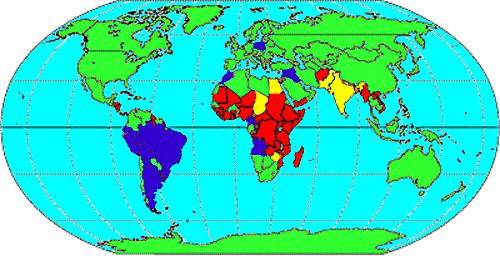A silent war; The devastating impact of debt on the poor
This print version has been auto-generated from https://www.globalissues.org/article/225/a-silent-war-the-devastating-impact-of-debt-on-the-poor
With kind permission from Jubilee Research1 (the successor to the
Jubilee 2000 campaign), an article, titled, A silent war; The devastating impact of debt on the poor
originally written in 1998 has been reposted here. You can also see the article at their web site:
http://www.jubileeresearch.org/analysis/reports/beginners_guide/silent.htm2.
On this page:
Introduction
Debt is tearing down schools, clinics and hospitals and the effects are no less devastating than war.

Map courtesy of For a Change
Key



Each year developing countries pay the West nine times more in debt repayments than they receive in grants.
- The UK Charity Comic Relief raised £26 million in 1997. Africa paid this back in debt service in just over a day.
- Each person in the Third World owes about £250 to the West - much more than a year's wage for many.
- Of the 32 countries classified as severely indebted low-income countries, 25 are in sub-Saharan Africa.
- Africa spends four times as much on debt repayment as she does on healthcare.
- In 1960, the income of the wealthiest 20 per cent of the world's population was 30 times greater than that of the poorest 20 per cent. Today it is over 60 times greater.
- For a billion people, development is being thrown into reverse. After decades of steady economic advance, large areas of the world are sliding back into poverty.
Millions of people around the world are living in poverty because of Third World debt and its consequences.
Latin America owes £365 billion in debts to other countries and banks (36 per cent of what it produces - its Gross National Product), while sub-Saharan Africa owes £140 billion (83 per cent of its total GNP). These enormous debts mean that repayments to Western Creditors take priority and ordinary people suffer: in poor health, in restricted access to education, in lack of employment and in limited ability to trade and provide for themselves.
Health
Spending on healthcare has fallen in many of the world's poorest countries since the 1980s. This often means that people have to pay for healthcare, so the poorest cannot afford it and simply go without. In Zimbabwe spending per head on healthcare has fallen by a third since 1990 when a Structural Adjustment Programme was introduced. In Uganda, £2 per person is spent on healthcare, compared with £11.50 per person on debt repayments.
Some improvements in health gained over the 1960s and 70s have been turned back or stopped in many countries since the 1980s when the debt crisis broke. The number of children who die before the age of five, or before the age of one, has risen in many deeply indebted countries, including Zimbabwe, Zambia, Nicaragua, Chile and Jamaica, after decades of falling numbers. Diseases thought to be eradicated - tuberculosis, yaws, yellow fever - are making a comeback in some countries as treatment and vaccination coverage declines.
Education
As schools are forced to charge fees, fewer people are able to send their children and education is mainly available only to the better-off.
In sub-Saharan Africa the damage to education has been particularly significant: the percentage of 6-11 year olds enrolled in school has fallen from nearly 60 per cent in 1980 to less than 50 per cent in 1990. In Tanzania, school fees have been introduced as part of a Structural Adjustment Programme, leading to a drop in primary and secondary school enrolment.
Employment
The IMF encourages hard-pressed governments to cut back spending and downsize government departments. This often means a rise in unemployment and a cut in wages.
Real wages in most African countries have fallen by 50-60 per cent since the early 1980s. In Mexico, Costa Rica and Bolivia average wages have fallen by a third since 1980. And unemployment has risen in many countries in Africa and Latin America since the 1980s - in Zambia, Tanzania and Ghana, over 20 per cent of the working population are unemployed. High levels of unemployment are counterproductive as there are fewer taxpayers to contribute to the public purse. So governments raise less through taxation.
Trade
SAPs mean that countries must increase their export crops - and as many poorer countries are encouraged to grow the same crops, they cause a glut on the international market and prices fall. So the workers on plantations and farms get lower wages than ever.
Mexico first grew maize as a staple crop thousands of years ago. But today, thanks to IMF economic policies, it has to import 20 per cent of this staple food from the USA.
The IMF encouraged Mexico to replace its vital food crops with cash crops - like strawberries and exotic fruits. The IMF also made sure that any trade protection for the country's agricultural goods was lifted. So Mexico's export crops now compete with those from the USA, which, as in many northern countries, are highly subsidised and protected, using all available techniques to improve their quality.
Mexico is the loser, and the poor suffer. Almost 20 per cent of Mexicans have no cash income; more than 30 per cent make less than the minimum wage of $3 a day.
Jubilee 2000 calls for...
cancellation of the backlog of unpayable debt of the poorest countries - most of which are in Africa. Such a cancellation will not on its own eradicate poverty - but it will remove a significant barrier to progress and justice. The year 2000 could signal the beginning of dramatic improvements in healthcare, education, employment and development for countries crippled by debt.
0 articles on “A silent war; The devastating impact of debt on the poor” and 2 related issues:
Third World Debt Undermines Development
Read “Third World Debt Undermines Development” to learn more.
Trade, Economy, & Related Issues
Read “Trade, Economy, & Related Issues” to learn more.
Author and Page Information
- Posted:
 Global Issues
Global Issues